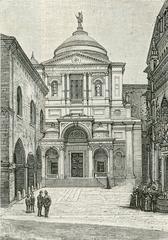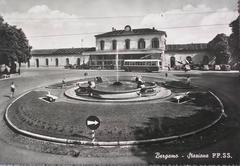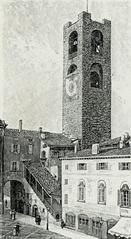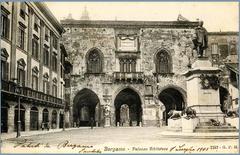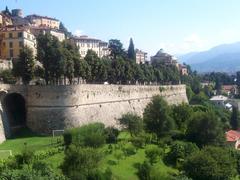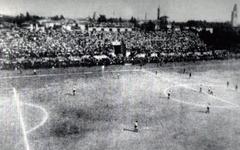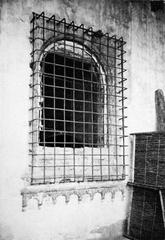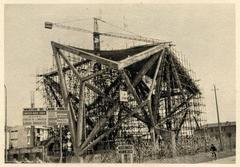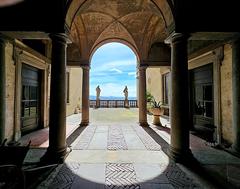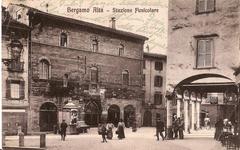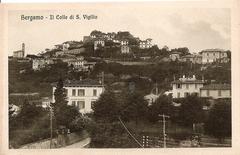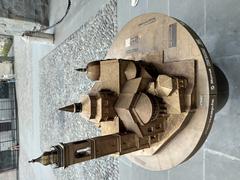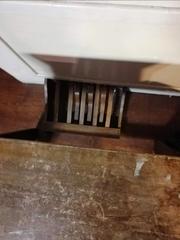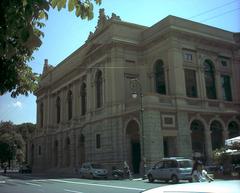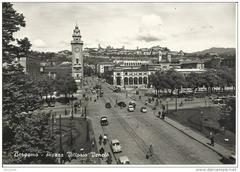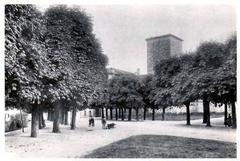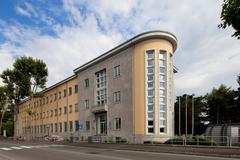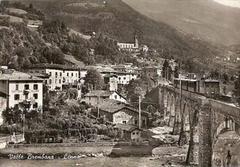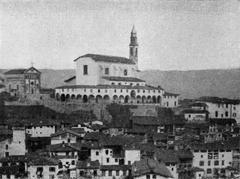
Monza–Trezzo–Bergamo Tramway: Comprehensive Visitor Guide
Date: 04/07/2025
Introduction: The Historic Monza–Trezzo–Bergamo Tramway
The Monza–Trezzo–Bergamo Tramway, fondly known as the “Gamba de Lègn” (Lombard dialect for “wooden leg”), is an emblematic chapter in Lombardy’s transport and industrial history. Established in 1890, this iconic tramway linked the towns of Monza, Trezzo sull’Adda, and Bergamo, facilitating the movement of people, goods, and information during a time of rapid industrialization. While the tramway ceased operations in 1958, its legacy continues through preserved sites, museum exhibits, and modern transport initiatives that echo its pioneering spirit (Microosio, TEB Route and Operation, Visit Bergamo).
For today’s visitors, the tramway offers a journey into Lombardy’s past—through walking and cycling trails on its former route, visits to local museums, and modern tram systems that build upon its legacy. This guide provides all the practical details needed: visiting hours, ticketing, accessibility, and tips for an enriching experience.
Table of Contents
- Historical Overview & Significance
- Route and Technical Details
- Operations, Evolution, and Cultural Impact
- Decline, Closure, and Preservation
- Exploring the Tramway Legacy: Sites, Museums & Trails
- The Modern Tramway in Bergamo: Features & Accessibility
- Visitor Information: Hours, Tickets, and Travel Tips
- Frequently Asked Questions (FAQ)
- Summary & Visitor Tips
- References
Historical Overview & Significance
The tramway was conceived at the height of Lombardy’s industrial expansion. With the growth of tram networks around Milan in the late 19th century, connecting Bergamo to this hub became vital. The challenge of crossing the Adda River was solved in the late 1880s, enabling the creation of the Monza–Trezzo–Bergamo line (microosio.it). The Società Anonima per la Tranvia Monza-Trezzo-Bergamo (MTB) was established in 1888, and the line opened officially in 1890, marking a new era in regional mobility (shop.ferrovie.it).
Route and Technical Details
The tramway spanned approximately 37 kilometers, connecting Monza to Bergamo in two main segments: 21.7 km from Monza to Trezzo and 16 km from Trezzo to Bergamo. Initially, the Monza terminus was situated on Via Enrico da Monza before moving to the railway station piazza in 1892 for improved train connections (lombardiarchivi.servizirl.it).
The line was built to a standard gauge (1,445 mm) and began with steam-powered trams, operating at a maximum speed of 15 km/h in rural areas and even slower in towns. Unique operational details included a flagman walking ahead of the tram in urban areas. The route traversed towns such as Brembate di Sotto, Boltiere, Osio Sotto, Dalmine, and Lallio, with specific engineering challenges like the narrow Brembo bridge requiring careful navigation (microosio.it).
Operations, Evolution, and Cultural Impact
Early Impact:
The tramway offered four daily departures each way (later doubled), with accessible fares and services that included transporting mail and valuables. The two-hour journey fostered regional integration and earned praise for its comfort and elegance.
Technological Evolution:
In the 1930s, accumulator-powered electric railcars were introduced, enhancing speed and cleanliness but limited by battery range and charging infrastructure. Steam power remained essential for peak times and freight, especially during postwar electricity shortages (microosio.it).
Cultural Significance:
The tramway became a fixture in local lore, celebrated in poetry and remembered for its leisurely pace and careful drivers. The nickname “Gamba de Lègn” reflects both affection and nostalgia for this unique mode of travel.
Decline, Closure, and Preservation
With the rise of faster bus services after WWII, the tramway’s relevance waned. The Trezzo–Bergamo segment closed in 1953, followed by the Monza–Trezzo section in 1958 (treniebinari.it). The closure marked the end of a regional era, but the tramway’s memory endures through preserved sites, museum exhibits, and interpretive trails (microosio.it).
Exploring the Tramway Legacy: Sites, Museums & Trails
Key Sites to Visit
- Bergamo Terminus (Via Paleocapa): Once the bustling end of the line, now marked by historical signage near the Hotel Mercure.
- Museo delle Storie di Bergamo: Offers exhibits on local transport history, including the tramway (Visit Bergamo).
- Trezzo sull’Adda Iron Bridge: Engineering landmark from the tramway era, accessible for pedestrians and cyclists.
- Monza Civic Museum: Occasionally features displays on the tramway’s local impact (Monza Net).
Trails & Experiential Routes
- Walking and Cycling Paths: Sections of the former right-of-way near the Adda River have been converted into recreational trails, with interpretive signs and scenic views.
- Bus Line Z301: Parallels much of the original route, offering a modern way to trace the tramway’s path (Nord Est Trasporti).
The Modern Tramway in Bergamo: Features & Accessibility
The T1 Tram Line
While not a direct successor, the T1 tram operated by Tramvie Elettriche Bergamasche (TEB) follows the tradition of rail-based transit in the region. Inaugurated in the 21st century, it covers 12.5 km and links several municipalities, serving over 220,000 residents (TEB Route and Operation).
Key Features
- Design Excellence: Sirio tramways designed by Pininfarina and Krizia offer comfort and style.
- Universal Accessibility: Low-floor vehicles, tactile maps, audio-visual announcements, and accessible ticket machines ensure inclusivity.
- Park & Ride: Parking facilities at major stops encourage sustainable travel.
- Integration: Seamless transfers with ATB and SAB Autoservizi, with unified ticketing across regional transport.
Sustainability
Initiatives such as “Tram&Bike” promote multimodal commuting, with cycle lanes and bike-sharing services integrated into the tram system.
Visitor Information: Hours, Tickets, and Travel Tips
Museums & Historical Sites
- Museo delle Storie di Bergamo:
Open Tuesday–Sunday, 10:00 AM–6:00 PM. Adult tickets €7; discounts available. - Monza Civic Museum:
Typically open Tuesday–Sunday, 9:00 AM–6:00 PM. - Trezzo sull’Adda Castle:
Open daily, 10:00 AM–7:00 PM. Occasionally hosts transport-related exhibitions.
Transport Tickets & Fares
- Tramway Tickets:
ATB and SAB tickets are valid on the T1 tram and local buses. Purchase at stations, online, or via mobile apps (TEB Route and Operation). - Integrated Day Pass:
€8.50 for 24 hours of unlimited travel on Bergamo buses and funiculars. - Regional Trains:
Frequent service between Milan, Monza, and Bergamo; tickets available at stations and online.
Accessibility
- Most sites and the T1 tram offer wheelchair access and features for visually and hearing-impaired visitors.
- Some rural sections of the original tramway trail may be less accessible; check with local tourism offices for details.
Best Visiting Times
- Spring and Autumn: Pleasant weather and fewer crowds.
- Weekdays: Generally quieter than weekends.
Frequently Asked Questions (FAQ)
Q: Is the original Monza–Trezzo–Bergamo Tramway operational?
A: No, it was closed in 1958. Its route can now be explored via trails, bus routes, and museum visits.
Q: Can I buy combined tickets for museums and public transport?
A: Some museums offer combined tickets; public transport day passes are widely available.
Q: Are guided tours available?
A: Yes, local operators and museums offer guided and audio tours. Booking ahead is recommended.
Q: Is the route accessible for people with disabilities?
A: Modern trams and most museums are accessible; rural trails may pose challenges.
Q: How can I enhance my visit?
A: Use the Audiala app for self-guided audio tours and up-to-date information.
Summary & Visitor Tips
The Monza–Trezzo–Bergamo Tramway stands as a testament to Lombardy’s innovation, resilience, and community spirit. While the original tramway no longer runs, its story is kept alive through museums, preserved sites, and the modern T1 tram, which prioritizes accessibility and sustainability. Visitors can trace the tramway’s legacy by following scenic trails, participating in guided tours, and immersing themselves in local culture and cuisine.
Key Tips:
- Always check opening hours and book guided tours in advance.
- Consider a day pass for seamless travel throughout Bergamo.
- Download the Audiala app for digital guides and updates.
- Respect signage along trails, especially where paths cross private property.
Embrace the unique blend of history and innovation that the Monza–Trezzo–Bergamo Tramway offers, and let your journey connect you to the heart of Lombardy’s past and present (Microosio, TEB Route and Operation, Visit Bergamo).
References
- Exploring the History of the Monza–Trezzo–Bergamo Tramway: A Landmark in Lombardy’s Transport Heritage, Microosio.it
- Monza–Trezzo–Bergamo Tramway: Visiting Hours, Tickets, and Exploring Bergamo’s Historic Transit, TEB Route and Operation
- Visit Bergamo Tourism Portal
- Visiting the Monza–Trezzo–Bergamo Tramway Legacy: Tickets, Route, and Historical Sites, Nord Est Trasporti
- Monza–Trezzo–Bergamo Tramway: Visiting Hours, Tickets & Historical Sites Guide in Bergamo, Monza Net
- Storia della Tranvia Monza-Trezzo-Bergamo, Ferrovie.it Shop
- Linee Tranviarie Dismesse Lombardia, TrenieBinari.it
- Lombardia Archivi









